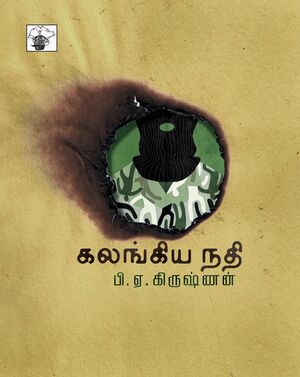Kalangiya Nathi
இந்தப் பக்கத்தை தமிழில் வாசிக்க: கலங்கிய நதி
Kalangiya Nathi (First Edition: 2011), a Tamil novel written by B.A. Krishnan. Set in the backdrop of the Assam state struggle. It tells the story of an employee of the authority system, confronting the contradictions, inactions, and absurdities of the organization to which he belongs, eventually getting expelled and then attaining clarity. The first version was written and published in English. Later the Tamil form was written with freedom by the author.
Gandhi is said to have spoken about the bloodshed during partition after India's independence "When a river floods it is silted up and more turbulent than ever. But it will become clear after the flood recedes. Clearer than ever". The title of the novel is based on the sentiments of the lines.
Creation
Kalangiya Nathi is the Tamil version of the English novel 'The Muddy River' written by B.A. Krishnan. It is a fiction based on true events during his tenure as a government official in Assam.
Author says the novel is dedicated "To our Sri Lankan brothers and sisters who continue to fight to preserve their identity".
Publication
Written in 2002, Kalangiya Nathi was revised in 2009 and the first edition was published by Kalachuvadu in December 2011. The second edition was released in August 2012.
Synopsis
The story unfolds within the novel written by Ramesh Chandran, a government official who has been dismissed and is recovering from an accident. Grieving the loss of their 10-year-old daughter, Ramesh Chandran and Sukanya's life becomes a turbulent river. Ramesh is transferred to Assam due to his brutal honesty and impudence. There he is sent as a victim in an attempt to free engineer Ghosh, a member of his department, who is kidnapped by the Assam militants and demanded a large sum of money. Tossed betwee The government, the police, the media, contractors, militants, Ghosh's wife, and he continues to do the things as much as he can. Gandhi's formula, which he learned from his father, gives him that motivation.
Anupama, another officer linked to the militants, also works with him. He realizes the incredible absurdities at every step of the Assam administration and the intricate dealings between the police and the militants. He gets support and help from Gandhian and former Chief Minister Rajavanshi. Ghosh is released. He also brings out the biggest scandal in the department. The department lays out baseless accusations and fires him. Anupama goes missing. Chandran writes his experiences as a novel.
The letters written by the friends Sabir and Herbert to Suganya and Suganya's response fill the gap between the incidents written by Chandran and many semblances of truth come out. One of them is that Chandran's role in the liberation of Ghosh is very small.
Characters
- Ramesh Chandran - Government Official
- Suganya - Chandran's Wife
- Priya - Daughter of Chandran & Suganya
- Bashirajan - Gandhian and Chandran's father
- Ghosh - The hostage taken by militants
- Nanditha Ghosh - Wife of Ghosh
- Nirmal Puyan - Police Officer
- Rajavanshi - A Gandhian, ex-chief minister, unsparingly honest. Fictional form of former Chief Minister Sarath Chandra Sinha
- Anupama Bugan - An officer associated with militants in Chandran's Organization, Bhuyan and Khaleda's college friend
- Kaleda - One of the leaders of the militants, Anupama's friend
- Baruva - Marxist, Professor
- Subir, Herbert - Chandran, Sukanya's friends. The next layer of the story is their letters
- Kashnapeas - Subir's media friend helps cut a deal by negotiating with the militant leader
- Head of the Organization
Literary Assessment
'Kalangiya Nathi' occupies an important place in the literature of Krithika, Aadhavan, Indira Parthasarathy, which criticizes the system of power in a subtle manner. The absurd drama of the power system is the essence of the novel.
Bhagadatta's story, the mass suicide of birds in Jadinga, the calves dedicated to the Krishna temple in Simmachalam and are immediately sold to the butchers, are profound parables for the Assamese youth who die inspired by extremism.
Kalangiya Nathi is an important work due to its fictional storytelling technique and strong allegory. The story is neatly woven in two layers with folds and insets. The novel the hero writes, the missing notes his wife adds to it, the reactions of the two friends who read it, along with the reader's guesswork – the truth of the story oscillates through it all. This strategy is new for Tamil. What Chandran has left unwritten and what he has changed helps us to know his subconscious.
Finding Gandhi in today's modern environment is said to be the greatest achievement of this novel.
"The fact that death is not only a loss but also a cause of spiritual evolution makes Kalangiya Nathi an important work. It is here that the subtle artifice of this novel comes into play" says writer Jeyamohan about this novel.
References
- Kalangalin Vidhimuraigal - B.A. Krishnanin Kalangiya Nathi - 1 Jeyamohan
- Kalangiya Nathi - Novel Assessment, M.A. Susheela, Vadakku Vasal, March 2012
Ready for review en
Please do not write any content below this line. This section is only for editing templates & categories.

